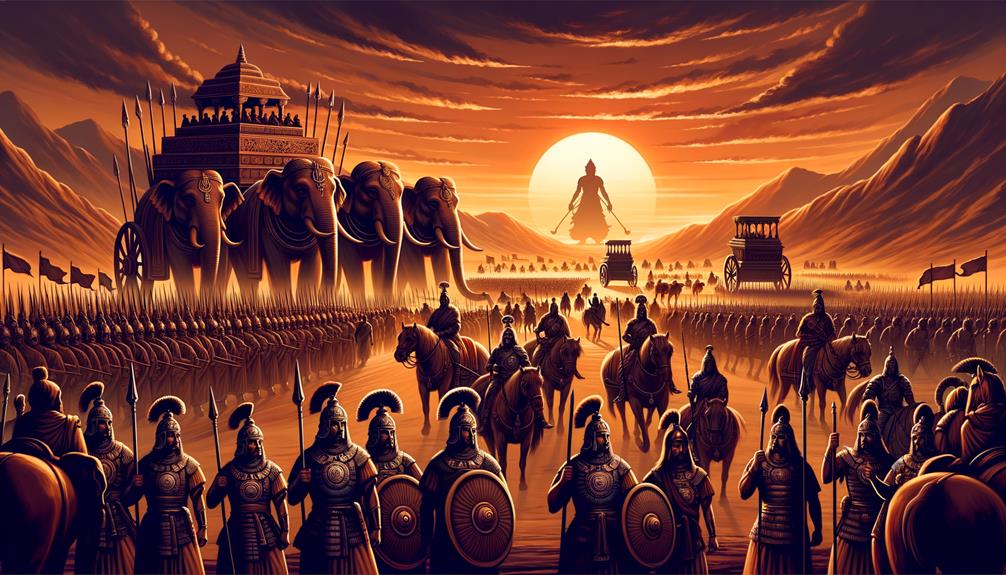The tale of Mahabharata is like an intricate art piece, skillfully crafted with elements of myth, philosophy, and history. It has always sparked my interest in a scholarly way. The story, abundant with complex characters and deep moral questions, continues to be relevant today. But it's more than just a war narrative – it delves into the truths of life, the essence of humanity, and the timeless battle of good versus evil. Let's journey together into this grand narrative, peel back its multiple layers, digest its meaningful lessons, and grasp its lasting influence on Indian culture, and even beyond. So, are we all set to navigate the vast sea of this epic, where every dip reveals a fresh gem?
Mahabharata's Textual History

When we take a closer look at the lavish textual history of the Mahabharata, we see it's more than just a tale. It's a complex web of ancient knowledge, meticulously crafted and recrafted over many centuries. This Sanskrit epic, believed to have been composed by the sage Vyasa, is not just the longest epic poem. It's a vibrant, bustling universe filled with stories inside stories. It has been narrated time and time again, but it never loses its brilliance.
The central theme of the Mahabharata is the intense feud between the Pandavas and the Kauravas, which eventually leads to the devastating Kurukshetra War. But the narrative doesn't stop here. It goes beyond this main clash, incorporating a wide range of side stories and distractions. It's much like a History Encyclopedia, providing invaluable perspectives on ancient Indian society, law, philosophy, and more.
When we dig a little deeper, we learn that Vyasa, the claimed writer, is also one of the characters in the epic. This fascinating twist in the narrative adds another dimension to the intricate web that is the Mahabharata. It's evidence of the epic's persistent relevance and its power to engage the imaginations of countless generations. Even though it's thousands of years old, it keeps being retold and reimagined.
Synopsis of the Epic Tale
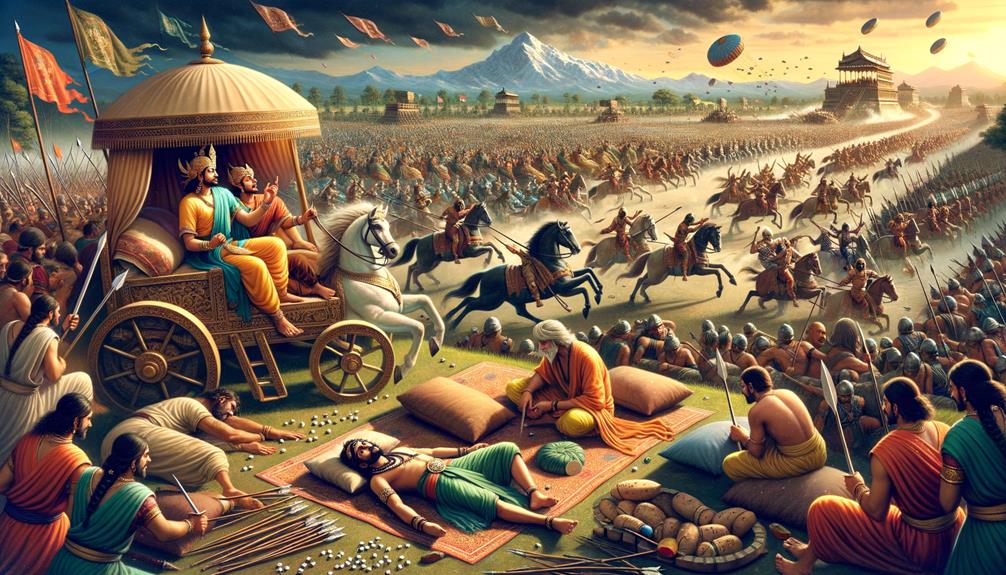
Let's chat about the epic tale of the Mahabharata, a massive saga that skillfully weaves together complex battles, deep philosophical thoughts, and enduring moral lessons. This ancient Indian story focuses on the intense feud between two families, the Kauravas and the Pandavas, with the Pandava brothers' journey to reclaim the throne of Hastinapura at its heart.
The firstborn Pandava, also the Crown Prince, is fooled into playing a fixed dice game by the King of Hastinapur. This results in the Pandavas being sent into exile. With their reputation damaged, the Pandavas, under the guidance of their mentor Drona, make a comeback to reclaim what they believe is rightfully theirs, setting off a devastating war.
In the heat of the battle unfolds the Bhagavad Gita, a sacred scripture where Lord Krishna offers his wisdom to a bewildered Arjuna, one of the Pandavas. It's a brilliant mix of philosophy and ethical teachings that have withstood the test of time.
The Mahabharata isn't merely a story about war and power; it reflects the human condition, delving into dharma, karma, and life's moral complexities. It's a tale that invites deep thought, a story steeped in life's most profound questions and their elusive answers.
Themes in Mahabharata
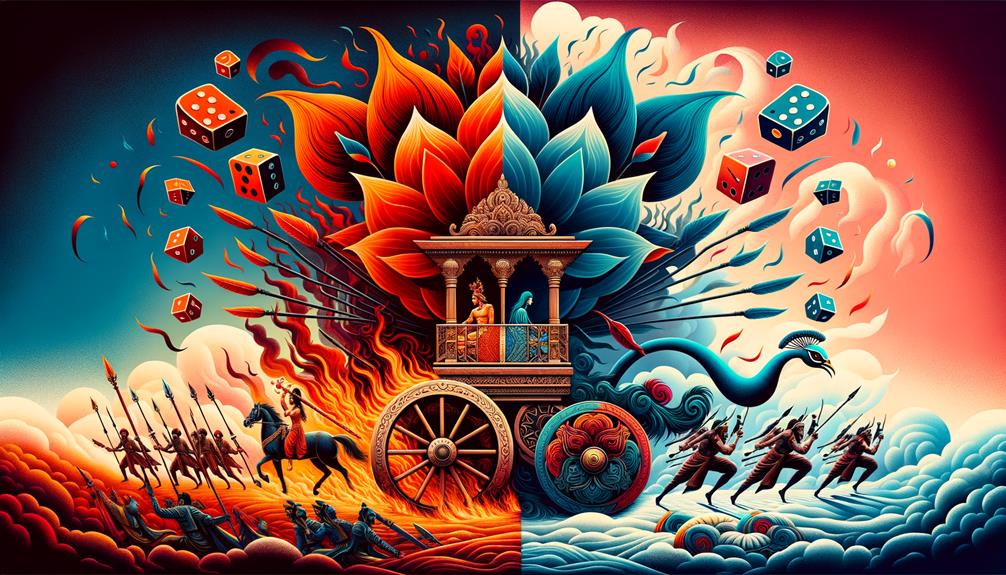
Let's have a chat about the themes in Mahabharata. They take us deep into the heart of its multifaceted narrative, offering us unique insights into concepts like dharma, family squabbles, political games, divine interference, and the intricacies of human nature. Now, the grand story of Mahabharata revolves around the royal family of the Kuru clan, with particular emphasis on the Kauravas and the Pandavas.
The main themes in Mahabharata that we come across are:
- Dharma: The oldest Kaurava, Duryodhana, and the Pandavas constantly grapple with dilemmas related to their dharma, challenging our own perception of what's right and what's wrong.
- Family and Conflict: Kunti, the mother of Pandavas, and Draupadi, their common wife, face severe difficulties due to family discord.
- Power and Politics: The hunger for power culminates in a catastrophic war, illustrating the disastrous potential of unchecked ambition.
- Divine Intervention: The fact that Krishna survives numerous attempts on his life, and the divine weapons used in the war, clearly point to the theme of divine intervention.
- Human Nature: The journey of each character reveals the chance for redemption and personal growth, nudging us to reflect on our own capacity for transformation.
In essence, the themes in Mahabharata act as a mirror reflecting our own world – showing us our darkest fears and brightest hopes.
Translations and Adaptations
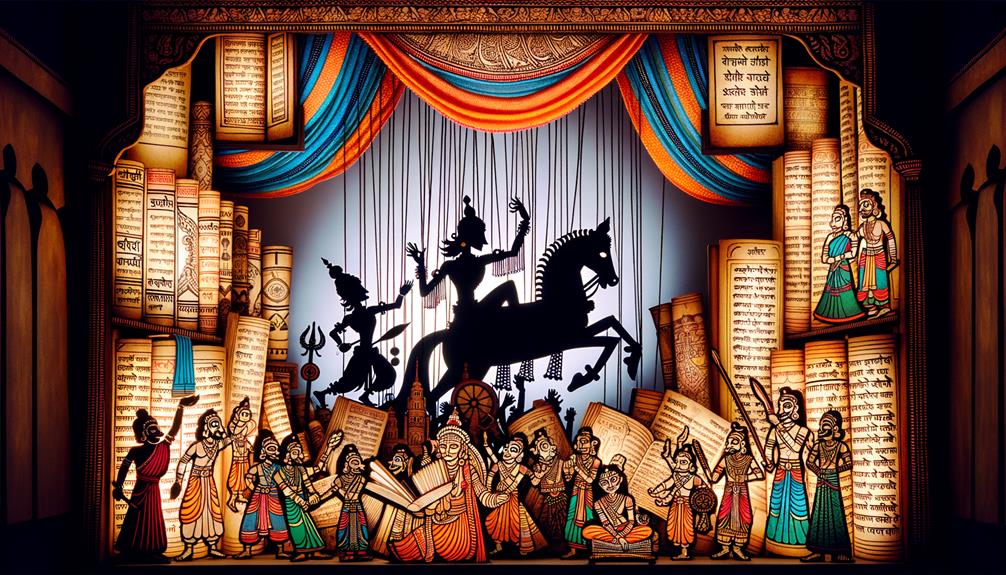
The Mahabharata, a tale that serves as a reflection of our world, has been shared and reshaped in countless ways, bridging vast cultural differences and sparking thought-provoking discussions around the globe. This ancient narrative, said to be the work of the sage Vyasa, has been around since the 8th or 9th century BCE and has touched the lives of people everywhere.
The saga tells the story of two feuding cousin clans, the five Pandava brothers and their rivals, the Kauravas. This tale has echoed in many cultures, and the Mahabharata's splendour is forever captured in the bas-reliefs of Angkor Wat in south-east Asia. The multiple adaptations and translations of the Mahabharata break down language barriers, making it a tale that people from all walks of life can connect with.
Its reach extends beyond just literature. It's found in theatre, films, and even the stories we tell each other every day. The Bhagavad Gita, a spiritual cornerstone of the Mahabharata, has been translated into numerous languages and continues to inspire countless individuals. The various translations and adaptations of this epic don't just preserve an ancient tradition. They also cultivate a global understanding of our shared human experiences and the challenges we face.
When rewriting this content, keep it simple and relatable. Break down complex sentences and replace fancy words with more straightforward alternatives. Stay relevant by using language that reflects current events and common parlance. Avoid overused phrases and aim for original expressions or direct descriptions. Use transition words sparingly and aim for a natural flow in your writing. Avoid exaggeration and stick to the facts, supporting claims with evidence where possible. Remember who you're writing for and adjust your language to fit their knowledge base. Choose an active voice to make your writing clearer and more direct. Instead of simply stating that something is 'important' or 'essential,' explain why it's significant. This makes the content more engaging and gives the reader a better understanding.
Cultural Influence of Mahabharata
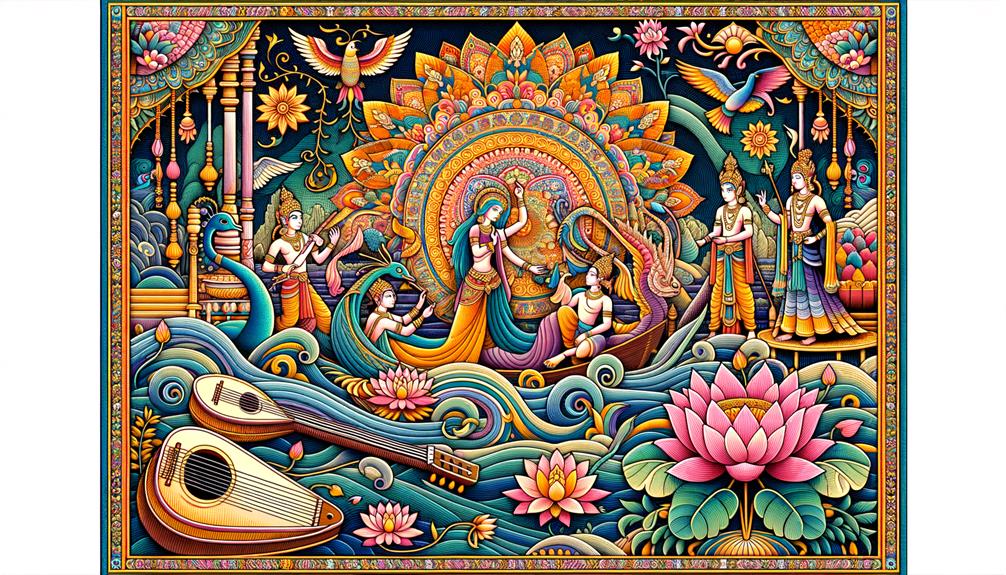
The Mahabharata has a significant cultural impact, deeply ingrained in Indian society and has travelled far and wide, influencing arts, literature, and religious beliefs all over the world. The epic story of Mahabharata, detailing the journeys of Pandavas and Kunti, the sons of Pandu, and their comeback to the Kuru clan continues to motivate and guide.
Let's see how the Mahabharata's cultural impact comes alive:
- The Pandavas' immense struggle, their marriage to Draupadi, and the countless challenges they encounter represent the human quest for righteousness.
- Yudhishthira, a character who loses everything but remains firm on his moral path, embodies values like truth and duty.
- The principles of the god Dharma act as the ethical and spiritual spine of Hindu culture.
- The vivid account of the brothers and Draupadi's banishment and return fortifies the belief in karma and divine justice.
- Its impact on art and literature, where the epic's characters, themes, and moral dilemmas offer a wealth of resources for creative and philosophical exploration.
Therefore, the cultural influence of the Mahabharata isn't just limited to its narrative. It also helps shape societal values, moral structures, and cultural identities.
Frequently Asked Questions
What Is the Epic Story of the Mahabharata?
The Mahabharata is a classic tale from ancient times. It dives deep into the saga of the Kurukshetra War, a conflict between the Kauravas and Pandavas. More than just a war story, it's a treasure chest of wisdom, featuring philosophical gems like the Bhagavad Gita. Plus, it doesn't stop at the war. The tale takes us beyond the battlefield, digging into the consequences and aftermath. It's a captivating narrative that doesn't just entertain, but teaches us about ethics and responsibilities in life.
What Is the Tale of Mahabharata?
The story of the Mahabharata is a sweeping tale about a royal family's fight for authority. It's an intricate web of moral challenges, divine interventions, and deep philosophical dialogues, including the respected Bhagavad Gita. It's truly a monumental narrative in its scope and depth.
What Is the Real Story of Mahabharata?
The Mahabharata, in the simplest terms, is a big deal. It's a captivating tale packed with aspects of love, deceit, and warfare. Think of it as a complex web, filled with intricate relationships and ethical issues – it's a real brain teaser. It delves into the concepts of responsibility, virtue, and life's cyclical nature, including birth and death. Trust me, it's a whole lot of deep thinking.
What Is the Epic Poem Mahabharata Mainly About?
The Mahabharata, at its heart, tells the tale of the Kurukshetra War, a mighty conflict between the Pandavas and Kauravas. But it's not just about war; it delves deep into topics of duty, destiny, and dharma. It's a complex story filled with moral lessons, offering insights into human nature and life's intricacies. If I were to sum it up, I'd say it's like a mirror held up to life itself, reflecting our virtues and flaws alike.

